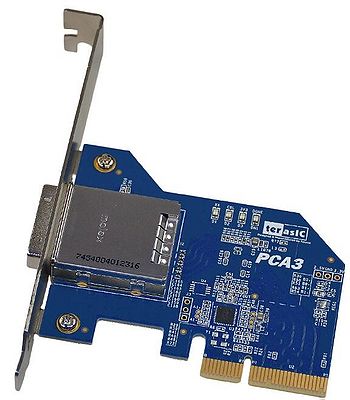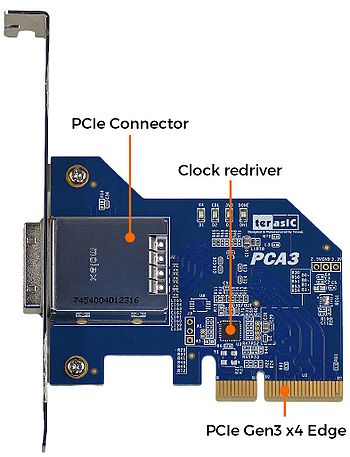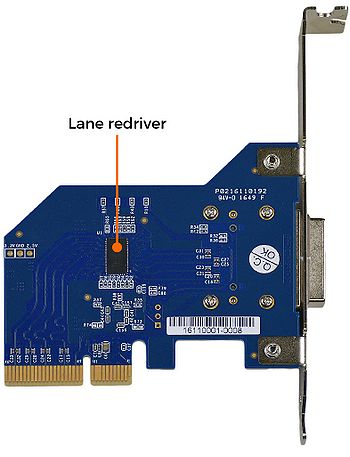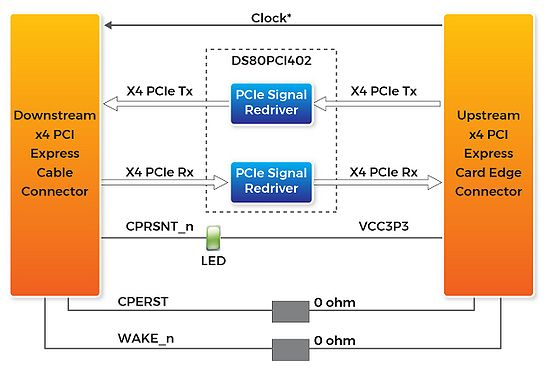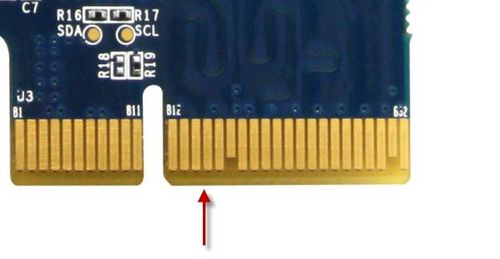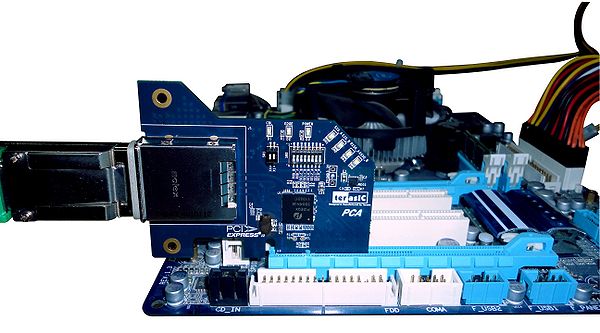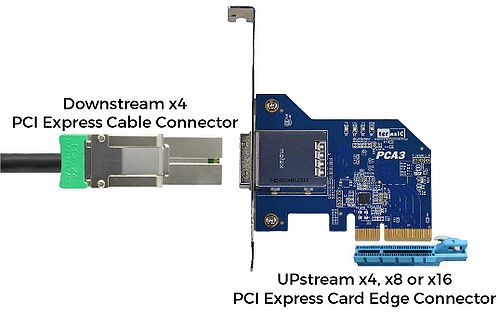PCA3 User Manual
From Terasic Wiki
Contents |
Chapter 1 Introduction
The Terasic PCIe x4 Cable Adapter (PCA3) is used to connect a PCIe upstream slot with downstream target board via PCIe x4 cable, supporting PCIe x4 & x1 lanes. The PCA3 can provide programmable equalization, amplification, and de-emphasis for PCIe transceiver signal by using 8 select bits. It is also available to optimize performance over a variety of physical mediums by reducing Inter-symbol interference.
Features
Figure 1-1 shows a photograph of the PCA3 card.
The key features of the card are listed below:
- Up to 8.0Gbps PCIe 3.0 Serial Re-Driver
- PCIe x4 Gen 3
- Adjustable receiver equalization
- Adjustable transmitter amplitude and de-emphasis
Getting Help
Here is information of how to get help if you encounter any problem:
Terasic Technologies
- Tel: +886-3-550-8800
- Email: support@terasic.com.cn
Chapter 2 Architecture
This chapter provides information about architecture and block diagram of the PCA3 board.
Layout and Components
The picture of the Terasic PCIe x4 Cable Adapter (PCA3) is shown in Figure 2-1 and Figure 2-2. It depicts the layout of the board and indicates the locations of the connectors and key components.
Block Diagram of the PCA3 Board
Figure 2-3 shows the block diagram of the PCA3 card.
Chapter 3 Board Components
This chapter describes the specifications of the onboard components.
PCIe Edge Connector
This PCIe edge connector is used to connect the PCA3 with PC motherboard PCIe slot, as show Figure 3-1 and Figure 3-2.
The pins are numbered as shown in Table 3-1 with side A on the top of the center-line on the solder side of the board and side B on the bottom of the centerline on the component side of the board.
The PCIe interface pins PETpx, PETnx, PERpx, and PERnx are named with the following convention: “PE” stands for PCIe high speed, “T” for Transmitter, “R” for Receiver, “p” for positive (+), and “n” for negative (-).
Note that adjacent differential pairs are separated by two ground pins to manage the connector crosstalk.
Table 3-1 gives the wiring information of the PCIe Edge connector.
- Table 3-1 Pin assignments and descriptions on PCIe Edge connector
Pin Numbers Side B Side A Name Description Name Description 1 NC NC PRSNT1n Hot-Plug presence detect 2 NC NC NC NC 3 NC NC NC NC 4 GND Ground GND Ground 5 SMCLK System Clock NC NC 6 SMDAT System Data Line NC NC 7 GND Ground NC NC 8 VCC3P3 3.3V Power NC NC 9 NC NC VCC3P3 3.3V Power 10 3.3VAUX 3.3V Auxiliary Power VCC3P3 3.3V Power 11 WAKE NC PERSTn Fundamental Reset Mechanical Key 12 RSVD Reserved GND Ground 13 GND Ground REFCLK+ Reference clock
(differential pair)14 PETp0 Transmitter differential
pair,Lane 0REFCLK- 15 PETn0 GND Ground 16 GND Ground PERp0 Receiver differential
pair, Lane 017 PRSNT2n Hot-Plug presence detect PERn0 18 GND Ground GND Ground 19 PETp1 Transmitter differential
pair,Lane 1RSVD Reserved 20 PETn1 GND Ground 21 GND Ground PERp1 Receiver differential
pair, Lane 122 GND Ground PERn1 23 PETp2 Transmitter differential
pair,Lane 2GND Ground 24 PETn2 GND Ground 25 GND Ground PERp2 Receiver differential
pair, Lane 226 GND Ground PERn2 27 PETp3 Transmitter differential
pair,Lane 3GND Ground 28 PETn3 GND Ground 29 GND Ground PERp3 Receiver differential
pair, Lane 330 RSVD Reserved PERn3 31 PRSNT2n Hot-Plug presence detect GND Ground 32 GND Ground RSVD Reserved
PCIe Cable Connector
A PCIe cable connector is used to connect the PCIe x4 Cable and PCA cable connector, connect the adapter by using a PCIe x4 Cable, as show Figure 3-3.
